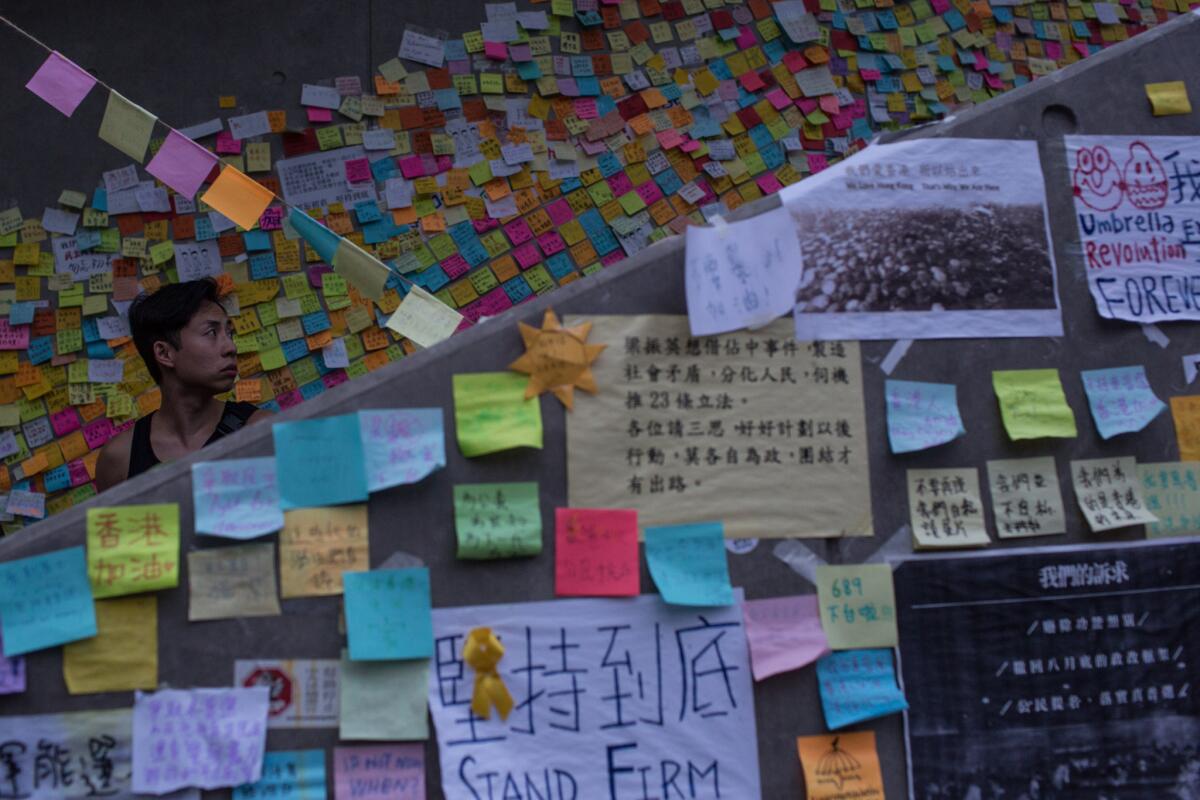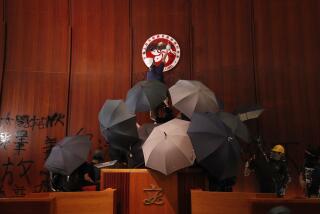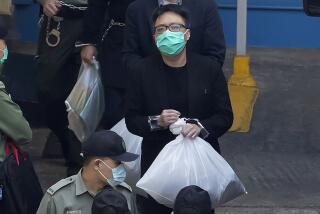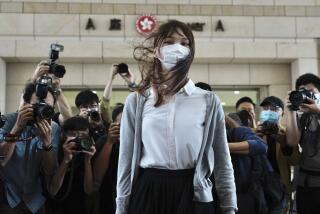Posters and poetry: Hong Kong protesters show their creativity

Hot pink and tangerine, chartreuse and bright blue, the Post-it notes flutter up the outdoor stairway like thousands of fragile Technicolor butterflies, clinging hopefully to the concrete wall of the government office. “We love Hong Kong.” “We are sad, we are angry.”
Individually, the miniature multilingual missives are mere whispers. Massed together, they’ve become a roar in rainbow colors: “Committed citizens can always change the world!” “Down with Communism!” “I want to vote for someone I want, not someone chosen by CHINA!”
For seven days, Hong Kongers have poured into the streets to press for democratic elections in 2017, singing and chanting at the top of their lungs. But quietly, they also have poured out their emotions and aspirations on paper and cardboard, Styrofoam and cloth, creating a striking sea of signage -- poetic and poignant, ironic and irate, whimsical and witty.
A visual and linguistic labyrinth written mainly in Chinese and English (both are official languages here), the banners and handbills, posters and stickers are layered with complex cultural references, historic as well as hip.
To wander among them in the protest zone, to read and reflect, is to touch this city’s Cantonese heritage and its British colonial era -- and appreciate more deeply its current Catch-22 as an au courant, cosmopolitan hub of globalized capitalism chafing under Chinese Communist rule.
There are numerical riddles to decipher, and visual puns too. Signs using “928” refer to Sept. 28, the day police tear-gassed and pepper-sprayed protesters. Others reading “689 step down” urge the unpopular Beijing-backed chief executive, Leung Chun-ying, to quit; Leung won his job leading this territory of 7 million with just 689 votes from a 1,200-member selection committee, hence the derisive numeric nickname.
Posters depicting wolves also refer to Leung, whose name is a near homonym for the animal. In Chinese, much like in English, “wolf” has several negative connotations, from gluttony to lechery.
Wolves are hardly the only animals to be found here. With the movement having taken on the sobriquet of the Umbrella Revolution, the raincoat-clad Paddington Bear is showing up on protest-zone posters too, brolly in hand.
Also spotted: the Morton Salt “When It Rains It Pours” umbrella girl.
Some art students have done sketches or watercolors of protest scenes, including students with goggles and masks (to protect against tear gas), rendered in Japanese anime style.
A number of expressive protesters have drawn on more classical traditions. A protest poem entitled “National Mourning” went viral this week on Twitter and other social media. Penned in traditional Chinese characters on a wooden crate that made up part of a barricade near demonstrators in the Tsim Sha Tsui neighborhood, was cleverly constructed so it could be read vertically as well as horizontally. The unsigned ode, written in Magic Marker, seemed to contain several hidden anti-Communist phrases.
“The level of participation in these protests is like nothing we’ve ever seen before, and so I think the level of creativity is also something we’ve not seen before,” said Lian-Hee Wee, an associate professor of English at Hong Kong Baptist University who on Saturday was out in Admiralty, the heart of the protest zone. “I feel like everyone is digging out whatever latent talent they have and trying to apply it here.”
Wee was sitting underneath a freeway overpass bearing a blue metal highway exit sign for Cotton Tree Drive. Some industrious protester had supplemented that official sign with an intricately sewn copycat banner that perfectly imitated both the hue and the font used by the highway bureau. “Resistance Drive,” it said in Chinese, pointing to the left lane. To the right: “Peace, Freedom and Democracy (True).”
Taped to lampposts, slapped up in subway stations, affixed to highway dividers and bus shelters, the signs invoke an incredible mélange of historic and cultural figures from around the globe.
Along one 50-foot stretch of pavement in Admiralty alone are signs bearing quotes from John Lennon (“You may say I’m a dreamer, but I’m not the only one.”), Gandhi (“First they ignore you, then they laugh at you, then they fight you, then you win.”) and Tupac Shakur (“Real eyes realize real lies.”).
Words from Nelson Mandela, Margaret Thatcher and Deng Xiaoping are here too, along with bons mots from Chinese revolutionary Sun Yat-sen and – rather surprisingly -- even the great Communist Helmsman himself, Mao Tse-tung.
Quoting Mao at the start of the 1966-’76 Cultural Revolution, a sign taped to a concrete traffic barrier reads: “Any person who suppresses student movements will come to no good end.”
Wee, the professor, explained that whoever created the flier was attempting some irony -- and was not trying to equate Hong Kong’s student-led protests with the rampaging youthful Red Guards who touched off a decade of disaster on the mainland.
“The point is to say to Hong Kong’s leaders: You are going against not only your own people, but also against your Communist forefathers,” said Wee, who was offering tutoring sessions to students who have been sitting out classes for weeks to attend the rallies.
A short distance from the John Lennon banner, directly in front of government headquarters, students had created what they referred to as a “Democracy Wall” – and plastered it with thousands of more messages written on small note cards.
The original Democracy Wall was created in 1978, when China experienced a brief “Beijing Spring” period of liberalization after Mao’s death in 1976. The wall was launched by a poet, Huang Xiang, who decided to take the risk of posting anti-Mao verses he had secretly composed.
His odes advocating democracy and human rights briefly became a sensation in the Chinese capital, but Huang was later jailed and his work banned. He eventually went into exile in the United States.
So far, opponents of the democracy demonstrations have shown little inclination to match their foes in the signage department – either quantitatively or qualitatively.
In a week of criss-crossing this city on foot, by taxi and on subways, this correspondent spied only one small poster expressing opposition to the movement. It was taped outside a small metal shop in the city’s main Central financial district, reading: “Don’t Occupy Central. Preserve Our Rice Bowls.”
Among the democracy protesters, though, the dramatic twists and turns of each day spawn new signs. Jayce Lau woke up on Saturday morning determined to express her anger that police had not taken firmer action when a group of protest opponents – some of them alleged Triad gang members -- violently confronted democracy demonstrators on Friday.
Lau went out and bought a long bolt of black fabric for $18 and a can of white spray paint for $4. By 2 p.m., she and two friends were hoisting up a banner in Admiralty. It was not particularly artistic, but it was legible and direct: “Desire for True Democracy Won’t Be Defeated by Police-Mob Collusion and Paid Thugs.”
Nearby, an orange traffic sign pointing to the government’s headquarters in Admiralty had been amended with a piece of paper so it read: “Central Government and Triad Offices.”
Follow @JulieMakLAT on Twitter for news on the Hong Kong protests
More to Read
Start your day right
Sign up for Essential California for news, features and recommendations from the L.A. Times and beyond in your inbox six days a week.
You may occasionally receive promotional content from the Los Angeles Times.







